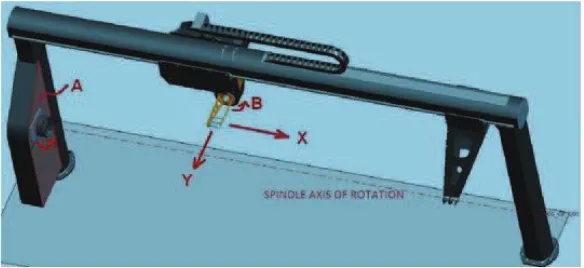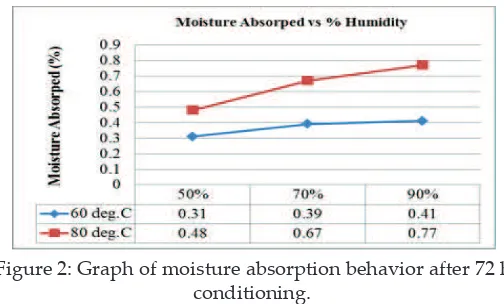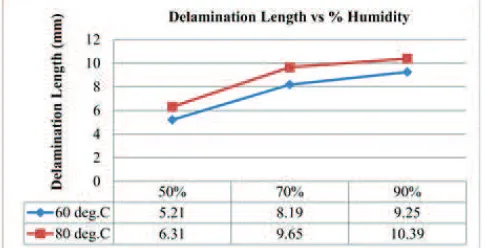ISSN: 1985-3157 Special Issue (TMAC) Symposium 2016 1
HYGROTHERMAL EFFECT ON MECHANICAL AND THERMAL PROPERTIES OF FILAMENT WOUND HYBRID COMPOSITE
Edynoor Osman1,2, Mohd Warikh Abd Rashid 1,2*, Mohd Edeerozey
Abd Manaf1, Efendi Mohamad1, Mohd Rizal Salleh1, Teruaki Ito2,
Toshihiro Moriga2
1Faculty of Manufacturing Engineering, Universiti Teknikal Malaysia Melaka (UTeM), Hang Tuah Jaya, 76100 Durian Tunggal, Melaka, Malaysia
2Tokushima-UTeM Academic Center, Tokushima University, 2-1 Minamo-Josanjima, 770-8506 Tokushima, Japan.
Email: *1,2[email protected]; 1,2[email protected]; [email protected]; [email protected]; [email protected];
[email protected]; [email protected]
ABSTRACT: This study focused on the hygrothermal efect on ilament wound glass-carbon/epoxy hybrid composite. Non-geodesic patern of ilament winding with a winding speed of 15.24–30.48 lm/min was used. Fiber tensioning weight of one kg and a winding angle of 30° were created to produce wound samples of the hybrid composite. The hybrid composite was wound by using a ±30° orientation with a total of six layers. Hygrothermal efect was conducted in a humidity chamber for three days (72 h). Control temperatures of 60 and 80°C were established, and humidity percentages of 50%, 70%, and 90% were used. Moisture absorption test showed that heat and humidity in most of the hybrid samples gradually increased. As a result, glass-carbon 80°C/90% showed the highest absorbed moisture at 0.77%. The involvement of highest heat and humidity showed the decline in the values of tensile and lexure strengths at 75.80 and 157.15 MPa, respectively. Fractography analysis using Stereo Microscope Stemi 2000-C indicated that glass-carbon/epoxy 80°C/90% showed catastrophic damage, large crack, and longest delamination of iber pullout at 10.39 mm. The fracture criterion revealed that the involvement of heat and humidity signiicantly afected the mechanical and physical properties of hybrid composite material.
KEYWORDS: Hygrothermal; ilament winding; hybrid composite;
1.0 INTRODUCTION
Polymer matrix composites, such as glass or carbon iber-reinforced composites, ofer enhanced fatigue behavior because microcracks in a polymer matrix do not freely propagate in a composite product and are conined in the iber, unlike in metal [1-2]. Normally, a polymer matrix composite is less afected by stress concentration, such as notches and holes, compared with metal. Hybrid composites have recently been highlighted as a new alternative to material composites, and many research activities have focused on hybrid technology, particularly for critical application in the automotive, aerospace, and engineering structural industries. Abu Talib et al., [1] developed a hybrid carbon/ glass iber-reinforced epoxy composite drive shaft for automotive application. In addition, composite drive shafts have been proven to be able to solve automotive and industrial problems that accompany the usage of conventional metal.
ISSN: 1985-3157 Special Issue (TMAC) Symposium 2016 3
characteristics compared with a conventional polymer composite material, heat and humidity remain signiicant factors that afect the mechanical and physical properties of hybrid composites. All polymer composites absorb moisture in a humid atmosphere and when immersed in water. The efect of moisture absorption leads to the degradation of the iber-matrix interface region, thereby creating poor stress transfer eiciencies that diminish mechanical properties [4-5]. Wu et al., [6] observed that the maximum reduction in interlayer shear performance occurred in the composite that is exposed to deionized water, whereas the maximum decrease in tensile performance is due to the efect of seawater. Chemical degradations also occurred in the iber-matrix interface, which reduced the bending modulus and strength of the composite [7]. Furthermore, iber-matrix interface and matrix failures increase in the composite specimen at a long immersion time in seawater [8]. If these materials are designed for exterior component applications such as tanks, pipes, and automotive parts, then high water uptake is mandatory. Therefore, investigating these problems is important.
2.0 EXPERIMENTAL
Glass-carbon as reinforcement and epoxy resin as matrix material were selected for the hybrid composite. These materials underwent ilament winding process to produce the samples. Figure 1 shows four axes of the ilament winding machine, which were used to fabricate the samples.
g e
Figure 1: Filament winder axis coniguration.
heat and humidity by using a humidity chamber (GOTECH). Heat temperatures were 60 and 80°C and humidity percentages were at 50%, 70%, and 90%, as shown in Table 1.
Table 1: Accelerated hygrothermal conditioning parameters
Moisture content, flexure, and tensile tests were conducted to determine the Conditioning
Moisture content, lexure, and tensile tests were conducted to determine the hygrothermal efects on the properties of ilament wound hybrid composite-reinforced epoxy. The percentage of moisture content was calculated after completely accelerating the hygrothermal efect. Flexure and tensile tests were conducted and further studied. Flexure and tensile tests strictly followed ASTM D790 and ASTM D638 standards, respectively. Microstructure analysis was conducted to observe the hygrothermal efect on the fracture morphology of the hybrid composite. The microstructure of the surface fracture and its criterion were investigated by using Carl Zeiss Stereo Microscope Stemi 2000-C. For thermal properties, the analysis was conducted by using Dilatometer Nezsch DIL 402 C to observe the thermal behavior after the hygrothermal efect.
3.0
RESULT AND DISCUSSIONS
3.1 Moisture absorption
ISSN: 1985-3157 Special Issue (TMAC) Symposium 2016 5
Figure 2: Graph of moisture absorption behavior after 72 h conditioning. Figure 2: Graph of moisture absorption behavior after 72 h
conditioning.
Glass-carbon/epoxy samples soaked at 80°C with 90% humidity shows the highest absorbed moisture compared with other parameters. Furthermore, higher moisture was absorbed in the samples as higher temperature was applied. Applying higher temperature causes the
hydrogen and oxygen (H2O) particles to become smaller and vaporize,
which makes the soaked samples easy to penetrate. Liao and Tan [9] reported that moisture absorption induced larger strains than high temperature exposure for unidirectional polymer composites primarily because the coeicient of moisture expansion was greater than the coeicient of thermal expansion. However, higher temperatures accelerate the difusion rates of moisture and generally accelerate aging [10].
3.2 Flexure properties
(c) (a) (b)
(a) (c)
(c)
(b)
Figure 3: Graph of lexural strength versus % humidity.
3.2.1 Flexure load fractography
The efect of lexure load on the hybrid samples was studied and observed by using Stereo Microscope Stemi 2000-C with 6.0x magniication. The delamination criterion of each sample after the application of lexure load was studied through morphology observation. The length of delamination for each sample after the application of lexure load was measured and explained.load was measured and explained.
Figure 4: Effect of flexure load on delamination of glass-carbon/epoxy at 60°C with
(c) (a) (b)
(a) (c)
(c)
(b)
Figure 4: Efect of lexure load on delamination of glass-carbon/epoxy at 60°C with various humidity percentages;
50% (a), 70% (b), and 90% (c).
Figure 5: Effect of flexure load on delamination of glass-carbon/epoxy at 80 °C with
(a) (b) (c)
Figure 5: Efect of lexure load on delamination of glass-carbon/epoxy at 80°C with various humidity percentages;
ISSN: 1985-3157 Special Issue (TMAC) Symposium 2016 7
Figure 6: Graph of delamination length generated after flexural test versus Figure 6: Graph of delamination length generated after lexural test
versus % humidity.
Figure 4 and 5 show the length of iber delamination that was generated at the interface of the samples after lexure load was applied. Figure 6 shows that glass-carbon/epoxy had the longest delamination after lexure load was applied, which indicates that applying higher temperature and humidity gradually increased the total length of delamination as considered in iber pullout from the matrix resin. Applied moisture and heat could strongly afect the structure of the composite material. According to Braj et al., [12] In contrast to iber breakage, iber pullout occurred in most of the samples because of a weak bond between the iber and the matrix at the interface. Hydroxyl groups (-OH) in the main backbone chain of a resin provided sites for hydrogen bonding to the surface of the natural ibers, which contain many hydroxyl groups in their chemical structure [12]. Thus, epoxy resins with no hydroxyl group in its backbone chain generally had the weakest bond and hence the lowest adhesive properties compared with other resins. According to Tsai et al., [10], moisture absorption also softens the matrix and degrades the stress transfer function, which results in a substantial loss of Tg and SBS strength. In this case, the iber will pull out of the matrix, which will result in loss of strength in the composite material.
3.3 Tensile properties
Figure 7: Graph of tensile strength versus % humidity.
(a) (b) (c)
Figure 7: Graph of tensile strength versus % humidity.
The efects with these two factors, namely, humidity and temperature, on the composite material were obvious. Absorbed moisture can damage the interface over time by interrupting the hydrogen bond within the matrix and iber, thereby weakening the interface. Furthermore, stresses created by swelling can be high and may eventually damage the interface. Moisture absorption causes plasticization of the resin, which occurs concurrently with swelling, and reduces the glass transition temperature of the resin. This condition adversely afects the iber matrix adhesion properties, which results in debonding at the iber-matrix interfaces as well as microcracking in the matrix, iber fragmentations, continuous cracks, and several other phenomena that degrade the mechanical property of the composites [12,16]. Degradation due to the hygrothermal environment damages the iber-matrix interface, which generally decreases the strength and modulus. Moisture absorption also softens the matrix, degrades the stress transfer function, and results in a substantial loss of glass temperature and strength of the material [10].
3.3.1 Tension load fractography
After the tensile test, the samples were observed based on their fracture criterion. The characteristics of the fracture revealed the efect of heat and humidity on the hybrid samples.
ISSN: 1985-3157 Special Issue (TMAC) Symposium 2016 9
Figure 8 and 9 show the catastrophic damage on the samples after tension load was applied. The highest temperature at 80°C and humidity at 90% caused breakage in the samples. Glass-carbon/epoxy, 80°C/90% samples showed serious defects such as iber breakage and laminate cracks compared with other parameters. Therefore, applying moisture and heat could afect the structure of the composite material. Wan et al., [13] stated that degradation due to the hygrothermal environment often damages the iber-matrix interface and generally decreases the strength and modulus.
Figure 9: Effect of tension load on the fracture of glass-carbon/epoxy at 80 °C with various humidity percentages; (a) 50%, (b) 70% and (c) and 90%.
( C) / sion
Figure 9: Efect of tension load on the fracture of glass-carbon/epoxy at 80 °C with various humidity percentages; (a) 50%, (b) 70% and (c) and
90%.
3.4 Thermal properties
Table 2 shows that the Tg of the glass-carbon/epoxy hybrid composite gradually decreased as humidity percentage increased. Glass-carbon/ epoxy 60 °C/90% had the lowest Tg at 61.8 °C. At 60 and 80 °C, both declined in Tg.
Thermal expansion increased as temperature rose from 60°C to 80°C as shown in Table 2. The applied heat softened the matrix, thereby causing the thermal expansion to increase. By contrast, thermal behavior after Tg point, which ranges from 80 °C to 100°C, indicated that the polymer matrix continued to soften as thermal expansion decreased. The trend showed that epoxy resin was afected by high temperature and had weak mechanical properties. As the amount of water absorbed by the composite
increased over a percentage of humidity, reductions in Tg and strength were measured. The change in Tg as a function of the moisture temperature and time is presented
in Table 2, which showed that the hygrothermal environment strongly afected the rate of decline of Tg. Researcher claimed that the presence of moisture within FRP can signiicantly change the chemical and physical characteristics of the polymeric matrix, which explains the efects of moisture on the matrix plasticization and degradation of the iber-matrix interface in most composite systems [11,14]. Moisture absorption by epoxy matrix composites has a plasticizing efect, as shown by Tg reduction in the matrix [15].
4.0 CONCLUSIONS
Glass-carbon/epoxy hybrid composite samples were hybridized by using the ilament winding process. Then, hybrid samples were conditioned to accelerate the hygrothermal efect at temperatures of 60 and 80 °C and humidity percentages of 50%, 70%, and 90%. Moisture absorption test showed that most of the hybrid samples gradually increased with the heat and humidity. As a result, glass-carbon 80 °C/90% showed the highest absorbed moisture at 0.77%. The highest levels of heat and humidity decreased the tensile and lexure strengths to 75.80 and 157.15 MPa, respectively. Thermal analysis
results showed the reduction in Tg as heat and humidity increased, which indicates the
hygrothermal efect. Fractography analysis by using Stereo Microscope Stemi 2000-C showed catastrophic damage, large crack, and longest delamination of iber pullout for glass-carbon/epoxy 80 °C/90%. The fracture criterion revealed that the involvement of heat and humidity signiicantly afected the mechanical and physical properties of the hybrid composite material.
ACKNOWLEDGEMENT
Authors would like to thank the Universiti Teknikal Malaysia Melaka and Malaysian
Ministry of Higher Education for support of this work under the MTUN COE Research Grant Scheme (MTUN/2012/UTHM-FKP/4 M0004).
REFERENCES
ISSN: 1985-3157 Special Issue (TMAC) Symposium 2016 11
[3] M. Bannister, “Challenges for composites into the next millennium – a reinforcement perspective”. Composite: Part A, 32, 901-990, 2001. [4] G.C. Yang, H.M. Zeng, L.J. Jian, N.B, “Relation of modiication and
tensile properties of sisal ibre”. ACTA Science National University Sunyatseni, 35, 53-57, 1996.
[5] E. Talib, M. Asyadi Azam, N. Noraiham, A.R.M. Warikh, “Fabrication and characterization of epoxidized natural rubber reinforced single-walled carbon nanotubes nanocomposite”. International Conference on Design and Concurrent Engineering, 2012. DoI: 10.3923/ rjasci.2014.344.349.
[6] L. Wu, K. Murphy, V.M Karbhari, J.S. Zhang, “Short-term efects of sea water on E glass/vinylester composites”. J Appl Polym Sci, 84, 2760-2767, 2002.
[7] A. Kootsookos, A.P. Mouriz, “Seawater durability of glass- and carbon- polymer composites”. Composite Science Technology, 64, 1503– 11, 2004.
[8] E.D. Mehmet, O. Okan, O. Mustafa, K. Ramazan, “Failure pressure and impact response of glass–epoxy pipes exposed to seawater”.
Composites: Part B, 53, 355-361, 2013.
[9] K. Liao, Y.M Tan, “Inluence of moisture-induced stress on in situ iber strength degradation of unidirectional polymer composite”.
Composites B; 32, 365–70, 2001.
[10] Y.I. Tsai, E.J. Bosze, E. Barjasteh, S.R. Nut, “Inluence of hygrothermal environment on thermal and mechanical properties of carbon iber/ iberglass hybrid composites”. Composites Science and Technology 69, 432–437, 2009.
[11] S. Shivakumar, S. Shivarudraiah, “Efect of temperature on the hygrothermaland mechanical behavior of glass-epoxy laminates”.
International Journal of Advanced Engineering Technology. 225-231, 2010. [12] S.D. Braj, K.G. Gaurav, B.B Verma, “Efect of hygrothermal treatment
on the tensile properties of hot pressed jute ibre composites”. National Institude of Technology Rourkela, 2008.
[13] Y.Z. Wan, Y.L. Wang, Y. Huang, H.L. Luo, F. He, G.C. Chen, “Moisture absorption in three-dimensional braided carbon/Kevlar/epoxy hybrid composite for orthopedic usage and its inluence on mechanical performance”. Composites A: 37, 1480–1484, 2006.
[14] M.F. Jane, M. Sergio, C.R. Mirabel, “Evaluation of mechanical properties of four diferent carbon/epoxy composite used in aeronautical ield”.
Material Research, 8 (1), 91-97, 2005.





